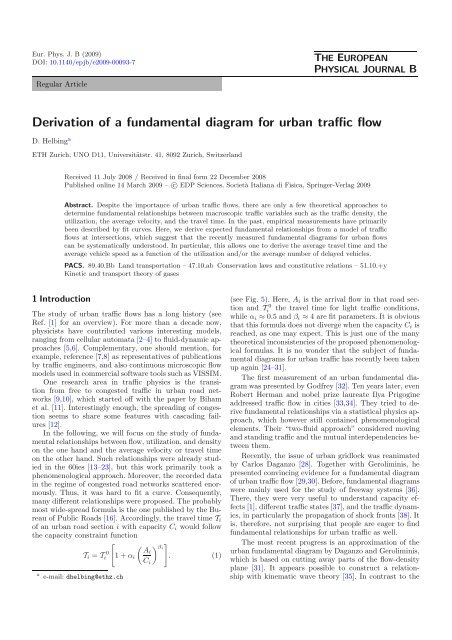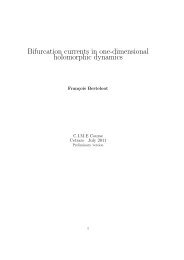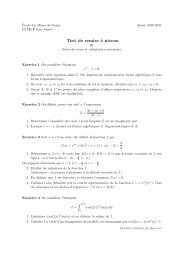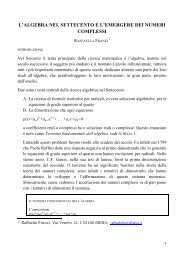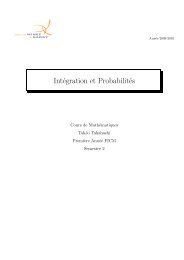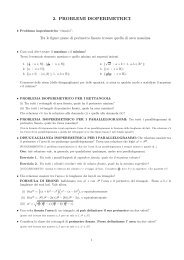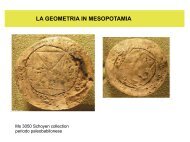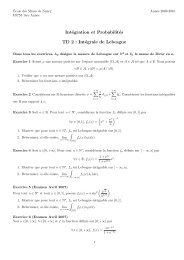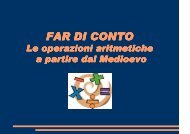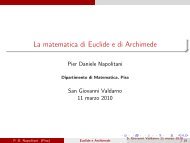Derivation of a fundamental diagram for urban traffic flow
Derivation of a fundamental diagram for urban traffic flow
Derivation of a fundamental diagram for urban traffic flow
Create successful ePaper yourself
Turn your PDF publications into a flip-book with our unique Google optimized e-Paper software.
Eur. Phys. J. B (2009)<br />
DOI: 10.1140/epjb/e2009-00093-7<br />
Regular Article<br />
THE EUROPEAN<br />
PHYSICAL JOURNAL B<br />
<strong>Derivation</strong> <strong>of</strong> a <strong>fundamental</strong> <strong>diagram</strong> <strong>for</strong> <strong>urban</strong> <strong>traffic</strong> <strong>flow</strong><br />
D. Helbing a<br />
ETH Zurich, UNO D11, Universitätstr. 41, 8092 Zurich, Switzerland<br />
Received 11 July 2008 / Received in final <strong>for</strong>m 22 December 2008<br />
Published online 14 March 2009 – c○ EDP Sciences, Società Italiana di Fisica, Springer-Verlag 2009<br />
Abstract. Despite the importance <strong>of</strong> <strong>urban</strong> <strong>traffic</strong> <strong>flow</strong>s, there are only a few theoretical approaches to<br />
determine <strong>fundamental</strong> relationships between macroscopic <strong>traffic</strong> variables such as the <strong>traffic</strong> density, the<br />
utilization, the average velocity, and the travel time. In the past, empirical measurements have primarily<br />
been described by fit curves. Here, we derive expected <strong>fundamental</strong> relationships from a model <strong>of</strong> <strong>traffic</strong><br />
<strong>flow</strong>s at intersections, which suggest that the recently measured <strong>fundamental</strong> <strong>diagram</strong>s <strong>for</strong> <strong>urban</strong> <strong>flow</strong>s<br />
can be systematically understood. In particular, this allows one to derive the average travel time and the<br />
average vehicle speed as a function <strong>of</strong> the utilization and/or the average number <strong>of</strong> delayed vehicles.<br />
PACS. 89.40.Bb Land transportation – 47.10.ab Conservation laws and constitutive relations – 51.10.+y<br />
Kinetic and transport theory <strong>of</strong> gases<br />
1 Introduction<br />
The study <strong>of</strong> <strong>urban</strong> <strong>traffic</strong> <strong>flow</strong>s has a long history (see<br />
Ref. [1] <strong>for</strong> an overview). For more than a decade now,<br />
physicists have contributed various interesting models,<br />
ranging from cellular automata [2–4] to fluid-dynamic approaches<br />
[5,6]. Complementary, one should mention, <strong>for</strong><br />
example, reference [7,8] as representatives <strong>of</strong> publications<br />
by <strong>traffic</strong> engineers, and also continuous microscopic <strong>flow</strong><br />
models used in commercial s<strong>of</strong>tware tools such as VISSIM.<br />
One research area in <strong>traffic</strong> physics is the transition<br />
from free to congested <strong>traffic</strong> in <strong>urban</strong> road networks<br />
[9,10], which started <strong>of</strong>f with the paper by Biham<br />
et al. [11]. Interestingly enough, the spreading <strong>of</strong> congestion<br />
seems to share some features with cascading failures<br />
[12].<br />
In the following, we will focus on the study <strong>of</strong> <strong>fundamental</strong><br />
relationships between <strong>flow</strong>, utilization, and density<br />
on the one hand and the average velocity or travel time<br />
on the other hand. Such relationships were already studied<br />
in the 60ies [13–23], but this work primarily took a<br />
phenomenological approach. Moreover, the recorded data<br />
in the regime <strong>of</strong> congested road networks scattered enormously.<br />
Thus, it was hard to fit a curve. Consequently,<br />
many different relationships were proposed. The probably<br />
most wide-spread <strong>for</strong>mula is the one published by the Bureau<br />
<strong>of</strong> Public Roads [16]. Accordingly, the travel time T i<br />
<strong>of</strong> an <strong>urban</strong> road section i with capacity C i would follow<br />
the capacity constraint function<br />
a<br />
T i = T 0<br />
i<br />
[<br />
e-mail: dhelbing@ethz.ch<br />
1+α i<br />
(<br />
Ai<br />
C i<br />
) βi<br />
]<br />
. (1)<br />
(see Fig. 5). Here, A i is the arrival <strong>flow</strong> in that road section<br />
and Ti<br />
0 the travel time <strong>for</strong> light <strong>traffic</strong> conditions,<br />
while α i ≈ 0.5 andβ i ≈ 4 are fit parameters. It is obvious<br />
that this <strong>for</strong>mula does not diverge when the capacity C i is<br />
reached, as one may expect. This is just one <strong>of</strong> the many<br />
theoretical inconsistencies <strong>of</strong> the proposed phenomenological<br />
<strong>for</strong>mulas. It is no wonder that the subject <strong>of</strong> <strong>fundamental</strong><br />
<strong>diagram</strong>s <strong>for</strong> <strong>urban</strong> <strong>traffic</strong> has recently been taken<br />
up again [24–31].<br />
The first measurement <strong>of</strong> an <strong>urban</strong> <strong>fundamental</strong> <strong>diagram</strong><br />
was presented by Godfrey [32]. Ten years later, even<br />
Robert Herman and nobel prize laureate Ilya Prigogine<br />
addressed <strong>traffic</strong> <strong>flow</strong> in cities [33,34]. They tried to derive<br />
<strong>fundamental</strong> relationships via a statistical physics approach,<br />
which however still contained phenomenological<br />
elements. Their “two-fluid approach” considered moving<br />
and standing <strong>traffic</strong> and the mutual interdependencies between<br />
them.<br />
Recently, the issue <strong>of</strong> <strong>urban</strong> gridlock was reanimated<br />
by Carlos Daganzo [28]. Together with Geroliminis, he<br />
presented convincing evidence <strong>for</strong> a <strong>fundamental</strong> <strong>diagram</strong><br />
<strong>of</strong> <strong>urban</strong> <strong>traffic</strong> <strong>flow</strong> [29,30]. Be<strong>for</strong>e, <strong>fundamental</strong> <strong>diagram</strong>s<br />
were mainly used <strong>for</strong> the study <strong>of</strong> freeway systems [36].<br />
There, they were very useful to understand capacity effects<br />
[1], different <strong>traffic</strong> states [37], and the <strong>traffic</strong> dynamics,<br />
in particularly the propagation <strong>of</strong> shock fronts [38]. It<br />
is, there<strong>for</strong>e, not surprising that people are eager to find<br />
<strong>fundamental</strong> relationships <strong>for</strong> <strong>urban</strong> <strong>traffic</strong> as well.<br />
The most recent progress is an approximation <strong>of</strong> the<br />
<strong>urban</strong> <strong>fundamental</strong> <strong>diagram</strong> by Daganzo and Geroliminis,<br />
which is based on cutting away parts <strong>of</strong> the <strong>flow</strong>-density<br />
plane [31]. It appears possible to construct a relationship<br />
with kinematic wave theory [35]. In contrast to the
2 The European Physical Journal B<br />
density-based approach by Daganzo et al., we will pursue<br />
an alternative, utilization-based approach. This is common<br />
in queueing theory [39] and transportation planning,<br />
where <strong>for</strong>mulas such as the capacity constraint function<br />
(1) areused.<br />
After discussing elementary relationships <strong>for</strong> cyclically<br />
signalized intersections <strong>of</strong> <strong>urban</strong> road networks in Section<br />
2, we will start in Section 3 with the discussion <strong>of</strong><br />
undersaturated <strong>traffic</strong> conditions and derive a relationship<br />
<strong>for</strong> the average travel time as a function <strong>of</strong> the utilization<br />
or the number <strong>of</strong> delayed vehicles. Furthermore, we will<br />
determine a <strong>for</strong>mula <strong>for</strong> the average speed. In Section 4,<br />
we will extend the analysis to congested road conditions,<br />
where the intersection capacity is exceeded. Afterwards,<br />
in Section 5, we will indicate how to deal with oversaturated<br />
networks, where the link capacity is insufficient to<br />
take up all vehicles that would like to enter a road section.<br />
Finally, Section 6 provides a summary and discussion.<br />
In particularly, we will address issues regarding the<br />
transfer <strong>of</strong> link-based <strong>fundamental</strong> <strong>diagram</strong>s to <strong>urban</strong> areas.<br />
We also try to connect the density-based <strong>fundamental</strong><br />
<strong>diagram</strong> <strong>of</strong> Daganzo et al. with the utilization-based approach<br />
developed here.<br />
2 Elementary relationships <strong>for</strong> cyclically<br />
operated intersections<br />
Let us study a single intersection with a periodically operated<br />
<strong>traffic</strong> light. We shall have green phases j <strong>of</strong> duration<br />
ΔT j , during which one or several <strong>of</strong> the <strong>traffic</strong> streams i<br />
are served. β ij shallbe1,if<strong>traffic</strong>streami is served by<br />
green phase j, otherwiseβ ij =0.Thesetuptimeafter<br />
phase j shall require a time period τ j . It may be imagined<br />
to correspond to the time period <strong>of</strong> the amber light (although<br />
in practice, this has to be corrected <strong>for</strong> reaction<br />
times and intersection clearing times). The sum <strong>of</strong> setup<br />
times will be called the “lost service time”<br />
T los = ∑ j<br />
τ j , (2)<br />
while the sum <strong>of</strong> all green time periods and setup times<br />
will be called the “cycle time”<br />
T cyc = ∑ j<br />
(ΔT j + τ j )=T los + ∑ j<br />
ΔT j . (3)<br />
The green times are also sometimes expressed as fractions<br />
f j ≥ 0 <strong>of</strong> the cycle time, i.e.<br />
ΔT j = f j T cyc (4)<br />
with ∑ j f j < 1. After inserting this into equation (3) and<br />
rearranging terms, we get<br />
T los<br />
T cyc ({f j })=<br />
1 − ∑ j f , (5)<br />
j<br />
i.e. the cycle time is proportional to the lost service time<br />
T los .<br />
Assuming average in<strong>flow</strong>s A i per lane, the number <strong>of</strong><br />
vehicles belonging to <strong>traffic</strong> stream i, which must be served<br />
within one cycle time T cyc , amounts to A i T cyc .Inorder<br />
to avoid the <strong>for</strong>mation <strong>of</strong> growing queues (i.e. the onset <strong>of</strong><br />
congestion), the number <strong>of</strong> served vehicles per cycle time<br />
and lane must reach this value. The number <strong>of</strong> vehicles <strong>of</strong><br />
<strong>traffic</strong> stream i potentially served during the green phases<br />
ΔT j is given by ∑ j Q ijβ ij ΔT j per lane, where Q ij denotes<br />
the out<strong>flow</strong> capacity (discharge <strong>flow</strong>) per lane, when<br />
stream i is served by phase j. If we want to have a certain<br />
amount <strong>of</strong> excess capacity to cope with a variability <strong>of</strong> the<br />
in<strong>flow</strong>s, we may demand<br />
(1 + δ i )A i T cyc = ∑ j<br />
Q ij β ij ΔT j = ∑ j<br />
Q ij β ij f j T cyc (6)<br />
with δ i > 0. This linear set <strong>of</strong> equations may be solved<br />
<strong>for</strong> the green time fractions f j . In the following, we will<br />
assume the case, where not several <strong>traffic</strong> streams i are<br />
served in parallel by one and the same green phase, but<br />
where each phase j serves a single <strong>traffic</strong> stream i. Then,<br />
we may assume β ij =1,ifj = i, andβ ij =0otherwise.<br />
Furthermore, Q ij = Q ii = ̂Q i . With this, equation (6)<br />
implies<br />
f i (u i ,δ i )=(1+δ i ) A i<br />
̂Q i<br />
=(1+δ i )u i , (7)<br />
where<br />
u i = A i<br />
(8)<br />
̂Q i<br />
is called the utilization <strong>of</strong> the service or out<strong>flow</strong> capacity<br />
̂Q i (see Fig. 1). δ i ≥ 0 is a safety factor to cope with<br />
variations in the arrival <strong>flow</strong> (in<strong>flow</strong>) A i . According to<br />
equation (5) wemusthave<br />
0 < 1 − ∑ i<br />
f i =1− ∑ i<br />
(1 + δ i ) A i<br />
̂Q i<br />
. (9)<br />
Otherwise, we will have growing vehicle queues from one<br />
signal cycle to the next, corresponding to the congested<br />
<strong>traffic</strong> regime.<br />
Note that, at time t, thenumberN i (t) <strong>of</strong> vehicles per<br />
lane in the road section reserved <strong>for</strong> <strong>traffic</strong> stream i is<br />
given by the time integral <strong>of</strong> the arrival <strong>flow</strong> A i (t) minus<br />
the departure <strong>flow</strong> γ i (t)O i (t):<br />
∫ t<br />
N i (t) = dt ′[ ]<br />
A i (t ′ ) − γ i (t ′ )O i (t ′ ) . (10)<br />
t 0<br />
Here, the starting time t 0 must be properly chosen to give<br />
the correct initial number <strong>of</strong> vehicles on road section i.<br />
During the amber and red time periods, we set the permeability<br />
γ i (t) = 0, as there is no out<strong>flow</strong>, while γ i (t) =1<br />
during green phases. The departure <strong>flow</strong> O i per lane is<br />
given by the service capacity ̂Q i per lane, as long as there
D. Helbing: <strong>Derivation</strong> <strong>of</strong> a <strong>fundamental</strong> <strong>diagram</strong> <strong>for</strong> <strong>urban</strong> <strong>traffic</strong> <strong>flow</strong> 3<br />
integral <strong>of</strong> the arrival <strong>flow</strong> A i (t −Ti 0 ) expected at the end<br />
<strong>of</strong> road section i under free <strong>flow</strong> conditions. Altogether,<br />
the number <strong>of</strong> delayed vehicles can be calculated as<br />
Fig. 1. Schematic illustration <strong>of</strong> vehicle trajectories <strong>for</strong> a <strong>traffic</strong><br />
light, which has an amber and red time period <strong>of</strong> altogether<br />
(1 − f i)T cyc and a green time period <strong>of</strong> f iT cyc. Vehicles move<br />
<strong>for</strong>ward at the free speed Vi<br />
0 or are stopped in a vehicle queue<br />
(horizontal lines), which <strong>for</strong>ms during the amber and red time<br />
period behind the <strong>traffic</strong> light (located at the t-axis). The speed<br />
<strong>of</strong> the upstream moving congestion front is given by the arrival<br />
<strong>flow</strong> [38] and denoted by c i ≤ 0. The dissolution speed<br />
c 0 < 0 <strong>of</strong> congested <strong>traffic</strong> is a characteristic constant with<br />
|c 0|≥|c i| [6,40]. The average delay time can be determined by<br />
averaging over the waiting times in the triangular areas. Note<br />
that <strong>for</strong> the case <strong>of</strong> an excess greentime (f i >u i), vehicles may<br />
pass the <strong>traffic</strong> light without any delay.<br />
is a positive number ΔN i (t) > 0 <strong>of</strong> delayed vehicles. If<br />
Q out represents the characteristic out<strong>flow</strong> from congested<br />
<strong>traffic</strong> per lane into an area <strong>of</strong> free <strong>flow</strong>, the overall service<br />
capacity by all service lanes is given by the minimum <strong>of</strong><br />
the number <strong>of</strong> lanes I i used by vehicle stream i upstream<br />
the intersection, and the number I i ′ <strong>of</strong> lanes downstream<br />
<strong>of</strong> it:<br />
( )<br />
I i ̂Qi =min(I i ,I i ′ )Q out, i.e. ̂Qi =min 1, I′ i<br />
Q out .<br />
I i<br />
(11)<br />
When the vehicle queue <strong>for</strong>ming behind a <strong>traffic</strong> light has<br />
completely resolved, the out<strong>flow</strong> from the road section<br />
used by vehicle stream i drops from ̂Q i to a lower value.<br />
Then, if the greentime period continues, the out<strong>flow</strong> O i (t)<br />
per lane corresponds to the arrival <strong>flow</strong> A i (t−Ti 0)perlane<br />
expected at the end <strong>of</strong> road section i under free <strong>flow</strong> conditions<br />
[40]. Here, Ti 0 = L i /Vi<br />
0 represents the travel time<br />
under free <strong>flow</strong> conditions, which is obtained by division <strong>of</strong><br />
the length L i <strong>of</strong> the road section reserved <strong>for</strong> stream i by<br />
the free speed Vi 0 . Considering also the above definition<br />
<strong>of</strong> the permeabilities γ i (t) reflecting the time-dependent<br />
states <strong>of</strong> the <strong>traffic</strong> signal, we have<br />
{ ̂Qi if ΔN<br />
γ i (t)O i (t) =γ i (t)<br />
i (t) > 0,<br />
A i (t −Ti 0)otherwise.<br />
(12)<br />
The number ΔN i (t) <strong>of</strong>delayed vehicles per lane at time<br />
t on the road section reserved <strong>for</strong> vehicle stream i can be<br />
easily determined as well. In contrast to equation (10), we<br />
have to subtract the integral <strong>of</strong> the departure <strong>flow</strong> from the<br />
ΔN i (t) =<br />
∫ t<br />
dt ′[ ]<br />
A i (t ′ −Ti 0 ) − γ i(t ′ )O i (t ′ ) . (13)<br />
t 0<br />
If the <strong>traffic</strong> <strong>flow</strong> is organized as a vehicle platoon and the<br />
green phase is synchronized with its arrival at the <strong>traffic</strong><br />
light, the number <strong>of</strong> delayed vehicles is zero. However, if<br />
the <strong>traffic</strong> <strong>flow</strong> A i is uni<strong>for</strong>m, we find<br />
∫ t<br />
ΔN i (t) =A i · (t − t 0 ) −<br />
t 0<br />
dt ′ γ i (t ′ )O i (t ′ ). (14)<br />
Let us assume that t 0 denotes the time when the green<br />
phase <strong>for</strong> <strong>traffic</strong> stream i ended. Then, the next green<br />
phase <strong>for</strong> this <strong>traffic</strong> stream starts at time t ′ 0 = t 0 +(1−<br />
f i )T cyc ,asf i T cyc is the green time period and (1 − f i )T cyc<br />
amounts to the sum <strong>of</strong> the amber and red time periods.<br />
Due to O i (t) ≥ A i (t) andO i (t ′ 0) >A i (t ′ 0), t ′ 0 − t 0 =(1−<br />
f i )T cyc is also the time period after which the maximum<br />
number ΔNi<br />
max <strong>of</strong> delayed vehicles is reached.<br />
In case <strong>of</strong> a uni<strong>for</strong>m arrival <strong>of</strong> vehicles at the rate A i =<br />
u i ̂Qi per lane we have<br />
ΔNi max (u i , {f j })=A i (1 − f i )T cyc (f i )<br />
= u i ̂Qi (1 − f i )T cyc ({f j }) . (15)<br />
Since ̂Q i −A i is the rate at which this vehicle queue can be<br />
reduced (considering the further uni<strong>for</strong>m arrival <strong>of</strong> vehicles<br />
at rate A i ), it takes a green time period <strong>of</strong><br />
T i (u i , {f j })= A i(1 − f i )T cyc<br />
= u i(1 − f i )<br />
T cyc ({f j }),<br />
̂Q i − A i<br />
1 − u i<br />
(16)<br />
until this vehicle queue is again fully resolved, and newly<br />
arriving vehicles can pass the <strong>traffic</strong> light without any delay.<br />
Finally, let us determine the average delay time <strong>of</strong> vehicles.<br />
If we have a platoon <strong>of</strong> vehicles which is served by<br />
a properly synchronized <strong>traffic</strong> light, the average delay is<br />
Ti<br />
av = Ti<br />
min = 0. However, if we have a constant arrival<br />
<strong>flow</strong> A i , the average delay T av <strong>of</strong> queued vehicles is given<br />
i<br />
by the arithmetic mean (Ti<br />
max +Ti<br />
min )/2 <strong>of</strong>themaximum<br />
delay <strong>for</strong> the first vehicle in the queue behind the <strong>traffic</strong><br />
light, which corresponds to the amber plus red time period<br />
T max<br />
i ({f j })=(1− f i )T cyc ({f j }), (17)<br />
and the minimum delay Ti<br />
min = 0 <strong>of</strong> a vehicle arriving just<br />
at the time when the queue is fully dissolved. To get the<br />
average delay, we have to weight this by the percentage<br />
<strong>of</strong> delayed vehicles. While the number <strong>of</strong> vehicles arriving<br />
during the cycle time T cyc is A i T cyc ,thenumber<strong>of</strong><br />
undelayed vehicles is given by A i (ΔT i − T i ). Considering<br />
<strong>for</strong>mulas (4) and(16), the excess green time is<br />
ΔT i − T i = f i T cyc − u i(1 − f i )T cyc<br />
1 − u i<br />
= f i − u i<br />
1 − u i<br />
T cyc . (18)
4 The European Physical Journal B<br />
(1 − f i )/(1 − u i ) ≤ 1 <strong>of</strong> vehicles is delayed, together with<br />
equations (15) and(20) we find<br />
Fig. 2. Schematic illustration <strong>of</strong> vehicle trajectories and signal<br />
operation in the case f i = u i, where there are no excess green<br />
times so that the <strong>traffic</strong> light is turned red as soon as the vehicle<br />
queue has been fully resolved.<br />
Hence, the percentage <strong>of</strong> delayed vehicles is<br />
A i [T cyc − (ΔT i − T i )]<br />
A i T cyc<br />
=1− f i − u i<br />
1 − u i<br />
= 1 − f i<br />
1 − u i<br />
≤ 1. (19)<br />
Altogether, the average delay <strong>of</strong> all vehicles is expected<br />
to be<br />
T av<br />
i (u i , {f j })= (1 − f i)<br />
(1 − u i )<br />
Inserting equation (5) gives<br />
T max<br />
i ({f j })<br />
2<br />
= (1 − f i) 2 T cyc ({f j })<br />
. (20)<br />
1 − u i 2<br />
Ti av (u i , {f j })= (1 − f i) 2 T los<br />
(1 − u i ) 2(1 − ∑ j f j) , (21)<br />
while with equation (15) weobtain<br />
Ti<br />
av (u i , {f j })= 1 − f i ΔNi max (u i , {f j })<br />
. (22)<br />
1 − u i 2u i ̂Q i<br />
There<strong>for</strong>e, the average delay time is proportional to the<br />
maximum queue length ΔNi<br />
max , but the prefactor depends<br />
on f i = (1 + δ i )u i (or the safety factor δ i , respectively).<br />
In case <strong>of</strong> no excess green time (δ i =0and<br />
f i = u i ), we just have<br />
Ti av ({u j })=(1− u i ) T cyc({u j })<br />
=<br />
2<br />
=<br />
ΔN<br />
max<br />
i ({u j })<br />
2A i<br />
ΔN<br />
max<br />
i ({u j })<br />
2u i ̂Qi<br />
(23)<br />
(see Fig. 2).<br />
Similarly to the average travel time, we may determine<br />
the average queue length. As the average number<br />
<strong>of</strong> delayed vehicles is (ΔNi<br />
max +0)/2 andafraction<br />
ΔN av<br />
i (u i , {f j })= (1 − f i)<br />
(1 − u i )<br />
ΔN max<br />
i (u i , {f j })<br />
2<br />
(1 − f i ) 2 T cyc ({f j })<br />
= u i ̂Qi<br />
(1 − u i ) 2<br />
= u i ̂Qi Ti av (u i , {f j }). (24)<br />
This remarkably simple relationship is known in queuing<br />
theory as Little’s Law [39], which holds <strong>for</strong> time-averaged<br />
variables even in the case <strong>of</strong> non-uni<strong>for</strong>m arrivals, if the<br />
system behaves stable (i.e. the queue length is not systematically<br />
growing or shrinking). It also allows one to establish<br />
a direct relationship between the “average vehicle<br />
density”<br />
ρ av<br />
av<br />
ΔNi<br />
i = (25)<br />
L i<br />
on the road section used by stream i and the utilization<br />
u i = A i / ̂Q i ,namely<br />
ρ av<br />
i = u i ̂Q i Ti<br />
av<br />
. (26)<br />
L i<br />
Note that the average density ρ av<br />
i has the same dependencies<br />
on other variables as ΔNi<br />
av or Ti<br />
av , and an additional<br />
dependency on L i , i.e. the more natural quantity to use is<br />
the queue length ΔNi av .<br />
2.1 Efficiency <strong>of</strong> <strong>traffic</strong> operation<br />
In reality, the average delay time will depend on the timedependence<br />
<strong>of</strong> the in<strong>flow</strong> A i (t),andonhowwellthe<strong>traffic</strong><br />
light is coordinated with the arrival <strong>of</strong> vehicle platoons. In<br />
particular, this implies a dependence on the signal <strong>of</strong>fsets.<br />
In the best case, the average delay is zero, but in the worst<br />
case, it may also be larger than<br />
1 − u i<br />
T cyc ({u j })= (1 − u i)T los<br />
2<br />
2(1 − ∑ j u j) , (27)<br />
see equation (20) withf i = u i . We may, there<strong>for</strong>e, introduce<br />
an efficiency coefficient ɛ i by the definition<br />
Ti<br />
av ({u j },ɛ i )=(1− ɛ i ) (1 − u i)T los<br />
2(1 − ∑ j u j)<br />
or, considering equation (24), equivalently by<br />
(28)<br />
ΔNi<br />
av<br />
(1 − u i )T los<br />
({u j },ɛ i )=(1− ɛ i )u i ̂Qi<br />
2(1 − ∑ j u j) . (29)<br />
For ɛ i = 1, the <strong>traffic</strong> light is perfectly synchronized with<br />
platoons in <strong>traffic</strong> stream i, i.e. vehicles are served without<br />
any delay, while <strong>for</strong> ɛ i = 0, the delay corresponds to<br />
uni<strong>for</strong>m arrivals <strong>of</strong> vehicles, when no excess green time<br />
is given. If the <strong>traffic</strong> light is not well synchronized with<br />
the arrival <strong>of</strong> vehicle platoons, we may even have ɛ i < 0.
D. Helbing: <strong>Derivation</strong> <strong>of</strong> a <strong>fundamental</strong> <strong>diagram</strong> <strong>for</strong> <strong>urban</strong> <strong>traffic</strong> <strong>flow</strong> 5<br />
It also makes sense to define an efficiencies not only <strong>for</strong> the<br />
<strong>traffic</strong> phases, but also <strong>for</strong> the operation <strong>of</strong> a <strong>traffic</strong> light<br />
(i.e. the full cycle). This can be done by averaging over<br />
all efficiencies ɛ i (and potentially weighting them by the<br />
number u i ̂Qi T cyc <strong>of</strong> vehicles arriving in one cycle. There<strong>for</strong>e,<br />
it makes sense to define the intersection efficiency as<br />
ɛ =<br />
∑<br />
i ɛ iu i ̂Qi<br />
∑i u i ̂Q i<br />
. (30)<br />
Note that, particularly in cases <strong>of</strong> pulsed rather than uni<strong>for</strong>m<br />
arrivals <strong>of</strong> vehicles, the efficiencies ɛ i depend on the<br />
cycle time T cyc and, there<strong>for</strong>e, also on the utilizations u i .<br />
Increasing the efficiency ɛ i <strong>for</strong> one <strong>traffic</strong> stream i will <strong>of</strong>ten<br />
(but not generally) reduce the efficiency ɛ j <strong>of</strong> another<br />
<strong>traffic</strong> stream j, which poses a great challenge to <strong>traffic</strong><br />
optimization.<br />
The exact value <strong>of</strong> the efficiency ɛ i depends on many<br />
details such as the time-dependence <strong>of</strong> the arrival <strong>flow</strong><br />
A i (t) and its average value A i , the length L i <strong>of</strong> the road<br />
section, and the signal control scheme (fixed cycle time<br />
or not, adaptive green phases or not, signal <strong>of</strong>fsets, etc.).<br />
These data and the exact signal settings are <strong>of</strong>ten not fully<br />
available and, there<strong>for</strong>e, it is reasonable to consider ɛ i as<br />
fit parameters rather than deriving complicated <strong>for</strong>mulas<br />
<strong>for</strong> them. Nevertheless, we will demonstrate the general<br />
dependence on the utilization u i in the following.<br />
For this, we will study the case <strong>of</strong> excess green times<br />
(δ i > 0), which are usually chosen to cope with the<br />
stochasticity <strong>of</strong> vehicle arrivals, i.e. the fact that the number<br />
<strong>of</strong> vehicles arriving during one cycle time is usually<br />
fluctuating. The choice δ i > 0, i.e. f i >u i , also implies<br />
A i T cyc<br />
T cyc<br />
= u i ̂Qi 0maybe<br />
derived from equations (21) and(28). We obtain<br />
1 − ɛ i = (1 − f i) 2<br />
(1 − u i ) 2 (1 − ∑ j u j)<br />
(1 − ∑ j f j) , (32)<br />
where f i (u i ,δ i )=(1+δ i )u i according to equation (7).<br />
The efficiency ɛ i is usually smaller than in the case, where<br />
the <strong>traffic</strong> light is turned red as soon as a vehicle queue<br />
has been dissolved (<strong>for</strong> exceptions see Ref. [41]). Then,<br />
ɛ i < 0<strong>for</strong>δ i > 0. Formula (32) also allows one to treat the<br />
case where the green time fractions f i and the cycle time<br />
T cyc are not adapted to the respective <strong>traffic</strong> situation,<br />
but where a fixed cycle time T cyc = Tcyc 0 andfixedgreen<br />
time fractions fi<br />
0 are implemented. This corresponds to<br />
constant green times<br />
fi 0 Tcyc({f 0 j 0 }) =<br />
f i 0T los<br />
1 − ∑ j f j<br />
0 . (33)<br />
In case <strong>of</strong> uni<strong>for</strong>m vehicle arrivals, we just have to insert<br />
the corresponding value f i = f 0 i into equation (32) to<br />
obtain ɛ i . In the case <strong>of</strong> non-uni<strong>for</strong>m arrivals, ɛ i can be<br />
understood as fit parameter <strong>of</strong> our model, which allows us<br />
to adjust our <strong>for</strong>mulas to empirical data and to quantify<br />
the efficiency <strong>of</strong> <strong>traffic</strong> light operation. In this way, we<br />
can also absorb effects <strong>of</strong> stochastic vehicle arrivals into<br />
the efficiency coefficients ɛ i , which simplifies our treatment<br />
alot.<br />
3 Fundamental relationships<br />
<strong>for</strong> undersaturated <strong>traffic</strong><br />
The travel time is generally given by the sum <strong>of</strong> the free<br />
travel time Ti 0 = L i /Vi<br />
0 and the average delay time Ti av ,<br />
where L i denotes the length <strong>of</strong> the road section used by<br />
vehicle stream i and Vi<br />
0 the free speed (or speed limit).<br />
With equation (24), we get<br />
T i ({u j },ɛ i )=T 0<br />
i<br />
+ T av<br />
i<br />
({u j },ɛ i )= L av<br />
i ΔNi ({u j },ɛ i )<br />
Vi<br />
0 + .<br />
u i ̂Qi<br />
(34)<br />
Inserting equation (29), we can express the travel time<br />
solely in terms <strong>of</strong> the utilization u i , and we have<br />
T i ({u j },ɛ i )= L i<br />
Vi<br />
0 +(1− ɛ i ) (1 − u i)T los<br />
2(1 − ∑ j u j) . (35)<br />
The <strong>for</strong>mula (35) constitutes a <strong>fundamental</strong> relationship<br />
between the average travel time Ti<br />
av on the capacity utilization<br />
u i under the assumptions made (mainly cyclical<br />
operation with certain efficiencies ɛ i ). Of course, one still<br />
needs to specify the factor (1 − ɛ i ). In case <strong>of</strong> constant arrival<br />
rates A i ,thisfactorisgivenbyequation(32), which<br />
finally results in<br />
T i (u i , {f j })= L i<br />
Vi<br />
0 + (1 − f i) 2<br />
(1 − u i )<br />
After insertion <strong>of</strong> equation (7), we get<br />
T i ({u j }, {δ j })= L i<br />
V 0<br />
i<br />
T los<br />
2(1 − ∑ j f j) . (36)<br />
[1 − (1 + δ i )u i ] 2 T los<br />
+<br />
(1 − u i )2[1 − ∑ j (1 + δ j)u j ] . (37)<br />
Sometimes, it is desireable to express the <strong>fundamental</strong> relationships<br />
in terms <strong>of</strong> the density rather than the utility.<br />
Inserting equation (35) intoTi<br />
av (u i ,ɛ i )=T i (u i ,ɛ i ) −<br />
L i /Vi 0 , and this into equation (26), we obtain the equation<br />
ρ av<br />
i<br />
({u j },ɛ i ,L i )= u i ̂Q i<br />
(1 − ɛ i ) (1 − u i)T los<br />
L i 2(1 − ∑ j u j) , (38)<br />
which can be numerically inverted to give the utilization u i<br />
as a function <strong>of</strong> the scaled densities ρ av<br />
j L j/(1−ɛ j ). The calculations<br />
are simpler in case <strong>of</strong> a fixed cycle time Tcyc 0 and<br />
an uni<strong>for</strong>m arrival <strong>of</strong> vehicles. By inserting equation (20)
6 The European Physical Journal B<br />
into (26) [andwithf i = f 0 i , T cyc = T 0 cyc ,seeEq.(33)],<br />
we get<br />
L i ρ av<br />
i (u i , {fj 0 av<br />
})=ΔNi (u i , {fj 0 })<br />
(1 − fi 0 = u i ̂Qi )2 Tcyc 0 ({f j 0})<br />
, (39)<br />
2(1 − u i )<br />
which finally yields<br />
u i (ρ av<br />
i L i , {f 0 j }) =<br />
(<br />
̂Q 1+(1− fi 0 ) 2 i Tcyc 0 ({f j 0})<br />
) −1<br />
2ρ av .<br />
i L i<br />
(40)<br />
Thiscanbeinsertedintoequation(26) togive<br />
Ti<br />
av (ρ av<br />
i L i , {fj 0 }) =<br />
u i (ρ av<br />
i<br />
ρ av<br />
i L i<br />
L i , {fj 0}) ̂Q i<br />
3.1 Transition to congested <strong>traffic</strong><br />
= ρav i L i<br />
+(1− f 0 T cyc({f 0<br />
i<br />
̂Q )2 j 0})<br />
. (41)<br />
i<br />
2<br />
The utilizations u i increase proportionally to the arrival<br />
<strong>flow</strong>s A i , i.e. they go up during the rush hour. Eventually,<br />
∑<br />
f j = ∑ (1 + δ j )u j → 1, (42)<br />
j<br />
j<br />
which means that the intersection capacity is reached.<br />
Sooner or later, there will be no excess capacities anymore,<br />
which implies δ i → 0andf i → u i .Inthiscase,<br />
we do not have any finite time periods ΔT i − T i , during<br />
which there are no delayed vehicles and where the departure<br />
<strong>flow</strong> O i (t) agrees with the arrival <strong>flow</strong> A i . There<strong>for</strong>e,<br />
O i (t) =γ i (t) ̂Q i according to equation (12), and certain relationships<br />
simplify. For example, the utilization is given<br />
as integral <strong>of</strong> the permeability over one cycle time T cyc ,<br />
divided by the cycle time itself:<br />
u i = 1<br />
T cyc<br />
t i0+T<br />
∫ cyc<br />
t i0<br />
dt ′ γ i (t ′ ). (43)<br />
Moreover, in the case <strong>of</strong> constant in- and out<strong>flow</strong>s, i.e. linear<br />
increase and decrease <strong>of</strong> the queue length, the average<br />
number ΔNi<br />
av <strong>of</strong> delayed vehicles is just given by half <strong>of</strong><br />
the maximum number <strong>of</strong> delayed vehicles 1<br />
ΔN av<br />
i<br />
=<br />
max<br />
ΔNi<br />
. (44)<br />
2<br />
1 Note that the <strong>for</strong>mulas derived in this paper are exact<br />
under the assumption <strong>of</strong> continuous <strong>flow</strong>s. The fact that<br />
vehicle <strong>flow</strong>s consist <strong>of</strong> discrete vehicles implies deviations<br />
from our <strong>for</strong>mulas <strong>of</strong> upto 1 vehicle, which slightly affects<br />
the average travel times as well. In Figure 2, <strong>for</strong> example,<br />
the number <strong>of</strong> vehicles in the queue is Ni<br />
max − 1 rather<br />
than Ni<br />
max . There<strong>for</strong>e, the related maximum delay time is<br />
(1 − u i)T cyc(Ni<br />
max − 1)/Ni<br />
max , which reduces the average delay<br />
time Ti<br />
av by (1 − u i)T cyc/(2Ni max ).<br />
As a consequence, we have<br />
T i ({u j })= L i<br />
V 0<br />
i<br />
+ (1 − u i)T los<br />
2 ( 1 − ∑ j u ). (45)<br />
j<br />
The average speed Vi<br />
av <strong>of</strong> <strong>traffic</strong> stream i is <strong>of</strong>ten determined<br />
by dividing the length L i <strong>of</strong> the road section reserved<br />
<strong>for</strong> it by the average travel time T i = Ti<br />
0 + Ti av ,<br />
which gives<br />
V av<br />
i ({u j })=<br />
(<br />
L i<br />
T i ({u j }) =<br />
1<br />
V 0<br />
i<br />
) −1<br />
+ (1 − u i)T los<br />
2L i (1 − ∑ j u ,<br />
j)<br />
(46)<br />
and can be generalized with equation (28) tocaseswith<br />
an efficiencies ɛ i ≠0:<br />
V av<br />
i ({u j },ɛ i )=<br />
(<br />
1<br />
V 0<br />
i<br />
) −1<br />
(1 − u i )T los<br />
+(1− ɛ i )<br />
2L i (1 − ∑ j u .<br />
j)<br />
(47)<br />
Note, however, that the above <strong>for</strong>mulas <strong>for</strong> the average<br />
speed are implicitly based on a harmonic rather than<br />
an arithmetic average. When correcting <strong>for</strong> this, equation<br />
(46), <strong>for</strong> example, becomes<br />
V av<br />
i ({u j })=<br />
∣<br />
L i u i ̂Qi ∣∣∣∣<br />
({u j }) ln 1+<br />
ΔN max<br />
i<br />
ΔN<br />
max<br />
i ({u j })<br />
u i ̂Qi T 0<br />
i<br />
∣ . (48)<br />
As is shown in Appendix A, this has a similar Taylor approximation<br />
as the harmonic average (47). The latter is<br />
there<strong>for</strong>e reasonable to use, and it is simpler to calculate.<br />
As expected from queuing theory, the average travel<br />
time (45) diverges, when the sum <strong>of</strong> utilizations reaches<br />
the intersection capacity, i.e. ∑ j u j → 1. In this practically<br />
relevant case, the <strong>traffic</strong> light would not switch anymore,<br />
which would frustrate drivers. For this reason, the<br />
cycle time is limited to a finite value<br />
T max<br />
cyc ({u0 j })=<br />
T los<br />
1 − ∑ , (49)<br />
j u0 j<br />
where typically u 0 j ≤ u j. This implies that the sum <strong>of</strong><br />
utilizations must fulfill<br />
∑<br />
u j ≤ ∑ u 0 j =1− T los<br />
T max . (50)<br />
j<br />
j<br />
cyc<br />
As soon as this condition is violated, we will have an increase<br />
<strong>of</strong> the average number <strong>of</strong> delayed vehicles in time,<br />
which characterizes the congested regime discussed in the<br />
next section.<br />
4 Fundamental relationships <strong>for</strong> congested<br />
<strong>traffic</strong> conditions<br />
In the congested regime, the number <strong>of</strong> delayed vehicles<br />
does not reach zero anymore, and platoons cannot<br />
be served without delay. Vehicles will usually have to
D. Helbing: <strong>Derivation</strong> <strong>of</strong> a <strong>fundamental</strong> <strong>diagram</strong> <strong>for</strong> <strong>urban</strong> <strong>traffic</strong> <strong>flow</strong> 7<br />
wait several cycle times until they can finally pass the<br />
<strong>traffic</strong> light. This increases the average delay time enormously.<br />
It also implies that there are no excess green<br />
times, which means δ i = 0. Consequently, we can also assume<br />
O i (t) = ̂Q i , as long as the out<strong>flow</strong> from road sections<br />
during the green phase is not (yet) obstructed (otherwise<br />
see Sect. 5). Formula (13) applies again and implies <strong>for</strong><br />
time-independent arrival <strong>flow</strong>s A i<br />
ΔN i (t i0 + kT max<br />
cyc )=ΔN i(t i0 )+<br />
where<br />
u 0 i = 1<br />
kT max cyc<br />
t i0+kT max<br />
cyc<br />
∫<br />
t i0<br />
dt ′[ A i − γ i (t ′ ) ̂Q i<br />
]<br />
= ΔN i (t i0 )+(A i − u 0 i ̂Q i )kT max<br />
cyc , (51)<br />
t i0+kT max<br />
cyc<br />
∫<br />
t i0<br />
dt ′ γ i (t ′ ) 0).<br />
Assuming that t i0 is the time at which congestion sets<br />
in, equation (58) can be generalized to continuous time t,<br />
allowing us to estimate the number <strong>of</strong> additional stops <strong>of</strong><br />
a vehicle arriving at time t:<br />
⌊<br />
n s (u i , {u 0 j},t)=<br />
⌋<br />
A i (t − t i0 )<br />
̂Q i u 0 i T cyc max({u0<br />
j }) =<br />
⌊<br />
⌋<br />
u i (t − t i0 )<br />
u 0 i T cyc max ({u 0 j }) .<br />
(59)
8 The European Physical Journal B<br />
As Figure 3 shows, the delay time by each <strong>of</strong> the n s additional<br />
stops is (1−u 0 max<br />
i )Tcyc . Moreover, we can see that the<br />
triangular part <strong>of</strong> the vehicle queue in the space-time plot<br />
gives a further contribution to the delay time <strong>of</strong> vehicles.<br />
Applying equation (20) withf i = u i = u 0 i , the average<br />
time delay in this triangular part is (1 − u 0 max<br />
i )Tcyc /2, i.e.<br />
the arithmetic average between zero and the sum <strong>of</strong> the<br />
red and amber time period (amounting to (1 − u 0 max<br />
i )Tcyc ).<br />
In summary, the delay time <strong>of</strong> a newly arriving vehicle at<br />
time t (when averaging over the triangular part <strong>for</strong> the<br />
sake <strong>of</strong> simplicity), is<br />
max ⌊ ⌋<br />
Ti<br />
av (u i ,t)=(1− u 0 cyc ui (t − t i0 )<br />
i )T +<br />
2 u 0 i T cyc<br />
max (1 − u 0 max<br />
i )Tcyc<br />
( ⌊ ⌋)<br />
1<br />
=<br />
2 + ui (t − t i0 )<br />
u 0 i T cyc<br />
max (1 − u 0 i )Tcyc max . (60)<br />
Accordingly, the average travel time does not only grow<br />
with time t (or the number k <strong>of</strong> cycles passed), it also<br />
grows stepwise due to the floor function ⌊x⌋.<br />
When we also average <strong>for</strong>mula (60) over its steps, we<br />
obtain the approximate relationship<br />
( )<br />
Ti<br />
av ui (t − t i0 )<br />
(u i ,t) ≈<br />
u 0 i T cyc<br />
max (1 − u 0 max<br />
i )Tcyc<br />
= u i (t − t i0 ) (1 − u0 i )<br />
u 0 , (61)<br />
i<br />
where it is important to consider that the floor function<br />
⌊x⌋ is shifted by 0.5 with respect to the function round(x),<br />
which rounds to the closest integer: round(x) =⌊x +0.5⌋.<br />
Moreover, when averaging over the last (k +1st) cycle<br />
we get<br />
(<br />
Ti av (u i ,k) ≈ u i k + 1 ) 1 − u<br />
0<br />
i<br />
2 u 0 Tcyc max . (62)<br />
i<br />
It is also possible to replace the dependence on the number<br />
k <strong>of</strong> cycles by a dependence on the average density <strong>of</strong><br />
delayed vehicles by applying equation (55). In this way,<br />
we obtain<br />
k + 1 2 = ΔNi<br />
av (u i , {u 0 j },k)<br />
(u i − u 0 i ) ̂Q i Tcyc max ({u 0 j }) − u0 i (1 − u i)<br />
2(u i − u 0 (63)<br />
i ).<br />
There<strong>for</strong>e, while in Section 3 we could express the average<br />
travel time and the average velocity either in dependence<br />
<strong>of</strong> the average density ρ av<br />
i or the utilization u i alone, we<br />
now have a dependence on both quantities.<br />
Finally note that equations (60) to(62) maybegeneralized<br />
to the case where the arrival rate <strong>of</strong> vehicles is<br />
not time-independent. This changes the triangular part <strong>of</strong><br />
Figure 3. In order to reflect this, the corresponding contribution<br />
(1 − u 0 max<br />
i )Tcyc /2 may, again, be multiplied with<br />
aprefactor(1− ɛ i ), which defines an efficiency ɛ i . While<br />
ɛ i = 0 corresponds to the previously discussed case <strong>of</strong> an<br />
uni<strong>for</strong>m arrival <strong>of</strong> vehicles, ɛ i = 1 reflects the case where a<br />
densely packed platoon <strong>of</strong> vehicles arrives at the moment<br />
when the last vehicle in the queue has started to move<br />
<strong>for</strong>ward.<br />
5 Fundamental relationships<br />
<strong>for</strong> oversaturated <strong>traffic</strong> conditions<br />
We have seen that, under congested conditions, the number<br />
<strong>of</strong> delayed vehicles is growing on average. Hence, the<br />
vehicle queue will eventually fill the road section reserved<br />
<strong>for</strong> vehicle stream i completely. Its maximum storage capacity<br />
per lane <strong>for</strong> delayed vehicles is<br />
ΔN jam<br />
i (L i )=L i ρ jam<br />
i , (64)<br />
where ρ jam<br />
i denotes the maximum density <strong>of</strong> vehicles per<br />
lane. The road section becomes completely congested at<br />
the time<br />
t = t i0 + kTcyc max + Δt, (65)<br />
when ΔNi min (u i ,k)+A i Δt according to equation (53)<br />
reaches the value ΔN jam<br />
i , which implies<br />
where<br />
Δt =<br />
ΔN<br />
jam<br />
i<br />
⌊<br />
k =<br />
(u i − u 0 i<br />
− ΔNi<br />
min (u i ,k)<br />
, (66)<br />
A i<br />
ΔN jam<br />
i<br />
)T<br />
max<br />
cyc<br />
⌋<br />
, (67)<br />
see equation (53). The number n s + 1 <strong>of</strong> stops is given by<br />
equation (59). See Figure 4 <strong>for</strong> an illustration.<br />
Complete congestion causes spillover effects and obstructs<br />
the arrival <strong>of</strong> upstream vehicles, even though the<br />
green phase would, in principle, allow them to depart.<br />
When these spill-over effects set in, we are in the oversaturated<br />
regime, and only a certain fraction σ i <strong>of</strong> the<br />
green phase <strong>of</strong> duration u 0 i T cyc<br />
max can be used, where 0 ≤<br />
σ i ≤ 1. Note that σ i decreases in time as the number <strong>of</strong><br />
blocked subsequent road sections grows. This may eventually<br />
lead to gridlock in a large area <strong>of</strong> the <strong>urban</strong> <strong>traffic</strong><br />
system.<br />
In the case σ i < 1, f i = u 0 i must essentially be replaced<br />
by f i = σ i u 0 i in the <strong>fundamental</strong> relationships <strong>for</strong><br />
congested <strong>traffic</strong>, and the lost service time becomes<br />
T los = ∑ [<br />
]<br />
τ i +(1− σ i )u 0 i Tcyc<br />
max . (68)<br />
i<br />
That is, the reduced service time may be imagined like an<br />
extension <strong>of</strong> the amber time periods. There<strong>for</strong>e, it would<br />
make sense to reduce the cycle time to a value T cyc
D. Helbing: <strong>Derivation</strong> <strong>of</strong> a <strong>fundamental</strong> <strong>diagram</strong> <strong>for</strong> <strong>urban</strong> <strong>traffic</strong> <strong>flow</strong> 9<br />
(u i −σ i u 0 i ) ̂Q i kT cyc < 0ineachcycle<strong>of</strong>lengthT cyc .Counting<br />
the number <strong>of</strong> cycles since the re-entering into the<br />
congested regime by k ′ ,wehave<br />
ΔNi<br />
min (u i ,k ′ )=ΔN jam<br />
i +(u i − σ i u 0 i ) ̂Q i k ′ T cyc , (71)<br />
and considering equation (15), the maximum number <strong>of</strong><br />
delayed vehicles is<br />
ΔNi<br />
max (u i ,k ′ )=ΔNi min (u i ,k ′ )+u i (1 − σ i u 0 i ) ̂Q i T cyc .<br />
(72)<br />
As soon as ΔNi<br />
min (u i ,k ′ ) reaches zero, the road section<br />
used by vehicle stream i enters the undersaturated regime.<br />
Be<strong>for</strong>e, the number <strong>of</strong> stops <strong>of</strong> vehicles joining the end <strong>of</strong><br />
the vehicle queue are expected to experience an number<br />
n s + 1 <strong>of</strong> stops with<br />
⌊<br />
n s (k ′ ui k ′ ⌋<br />
)=<br />
σ i u 0 , (73)<br />
i<br />
compare equation (58).<br />
Fig. 4. Schematic illustration <strong>of</strong> the service <strong>of</strong> vehicle queues,<br />
when the road section is fully congested. The lower horizontal<br />
line indicates the location <strong>of</strong> the upstream end <strong>of</strong> the road section.<br />
It can be seen that vehicles are stopped several times, and<br />
that new vehicles can only enter when some vehicles have been<br />
served by the <strong>traffic</strong> light located at the t-axis, and the space<br />
freed up by this has reached the end <strong>of</strong> the vehicle queue. For<br />
similar considerations see reference [35]. Note that the characteristic<br />
speed c 0 <strong>of</strong> the shock fronts (which corresponds to<br />
the slope <strong>of</strong> the congested <strong>flow</strong>-density relationship <strong>for</strong> a road<br />
section without the consideration <strong>of</strong> <strong>traffic</strong> lights) is different<br />
from the slope <strong>of</strong> the <strong>urban</strong> <strong>fundamental</strong> <strong>diagram</strong>, because <strong>of</strong><br />
the effect <strong>of</strong> signal <strong>of</strong>fsets and delays [31]. There<strong>for</strong>e, c 0 should<br />
be understood as fit parameter, here.<br />
and the average delay time Ti av = T i −Ti<br />
0 as<br />
T av<br />
i<br />
(u i ,σ i ,L i )= L iρ jam<br />
i<br />
σ i u 0 ̂Q<br />
− L i<br />
i i<br />
V 0<br />
i<br />
. (70)<br />
Note that these values are now independent <strong>of</strong> both, the<br />
utilization and the average density, as soon as the latter<br />
assumes the value ρ av<br />
i = ρ jam<br />
i , corresponding to a fully<br />
congested road section.<br />
5.1 Transition from oversaturated to undersaturated<br />
<strong>traffic</strong> conditions<br />
If the arrival <strong>flow</strong> A i after the rush hour drops below<br />
the value <strong>of</strong> σ i u 0 i T cyc max , the vehicle queue will eventually<br />
shrink, and the road section used by vehicle stream i enters<br />
from the oversaturated into the congested regime.<br />
The <strong>for</strong>mulas <strong>for</strong> the evolution <strong>of</strong> the number <strong>of</strong> delayed<br />
vehicles are analogous to equations (53) and(54).<br />
The queue length starts with ΔN jam<br />
i<br />
and is reduced by<br />
6 Summary and outlook<br />
Based on a few elementary assumptions, we were able to<br />
derive <strong>fundamental</strong> relationships <strong>for</strong> the average travel<br />
time Ti<br />
av and average velocity Vi<br />
av . These relationships<br />
are functions <strong>of</strong> the utilization u i <strong>of</strong> the service capacity<br />
<strong>of</strong> a cyclically signalized intersection and/or the average<br />
number ΔNi<br />
av <strong>of</strong> delayed vehicles (or the average density<br />
ρ av<br />
i <strong>of</strong> vehicles in the road section <strong>of</strong> length L i reserved <strong>for</strong><br />
<strong>traffic</strong> stream i). We found different <strong>for</strong>mulas, (1) <strong>for</strong> the<br />
undersaturated regime, (2) <strong>for</strong> the congested regime, and<br />
(3) <strong>for</strong> the oversaturated regime. While we also discussed<br />
situations, where fixed cycle times Tcyc 0 are applied, we primarily<br />
focussed on situations, where the cycle time is adjusted<br />
to the utilization u i (in the undersaturated regime)<br />
and to the effectively usable green time fraction σ i (in the<br />
oversaturated regime). Our results are summarized in Figure<br />
5, where also a comparison with the capacity restraint<br />
function (1) ismade.<br />
The <strong>for</strong>mulas <strong>for</strong> the non-congested regime can be either<br />
expressed as non-trivial functions <strong>of</strong> the utilization<br />
u i or the average queue length ΔNi<br />
av (or the average density<br />
ρ max<br />
i ). They contain a fit parameter ɛ i , which reflects<br />
effects <strong>of</strong> variations in the arrival <strong>flow</strong> and relates to the<br />
efficiency <strong>of</strong> <strong>traffic</strong> signal operation in terms <strong>of</strong> synchronizing<br />
with vehicle platoons. In the best case, delay times<br />
are zero, which shows the great optimization potential <strong>for</strong><br />
<strong>traffic</strong> control in this regime.<br />
In the congested regime, the number <strong>of</strong> delayed vehicles<br />
grows in time, and the majority <strong>of</strong> vehicles is stopped several<br />
times by the same <strong>traffic</strong> light. There<strong>for</strong>e, the average<br />
travel time does not only depend on the utilization u i , but<br />
also on the average vehicle queue ΔNi<br />
av (or the average<br />
density ρ av<br />
i ). Although the <strong>traffic</strong> light control can still improve<br />
the average travel times by synchronizing with the<br />
arrival <strong>of</strong> vehicles, the related efficiency effect is rather<br />
limited.
10 The European Physical Journal B<br />
Average Travel Time T i [T i<br />
0 ]<br />
10<br />
8<br />
6<br />
4<br />
2<br />
0<br />
0 0.2 0.4 0.6 0.8 1<br />
Utilization u i<br />
Fig. 5. (Color Online) Schematic illustration <strong>of</strong> the capacity<br />
restraint function (1) that the Bureau <strong>of</strong> Public Roads recommends<br />
to use [16] (solid line), together with analytical results<br />
<strong>of</strong> this paper (dashed lines). Travel time T i is measured in units<br />
<strong>of</strong> Ti 0 . The green long-dashed line shows that the travel time<br />
diverges at u i ≈ 0.45, if two green phases during one cycle<br />
and identical utilizations u 1 = u 2 <strong>of</strong> both associated road sections<br />
are assumed, furthermore, if the parameters are set to<br />
T los =0.1Ti<br />
0 and δ =0.1. (A generalization to <strong>traffic</strong> operation<br />
with more than two green phases is easily possible.) When<br />
the cycle time is limited to a finite value Tcyc<br />
max to avoid infinite<br />
delay times in one <strong>of</strong> the vehicle queues, one will have growing<br />
vehicle queues and increasing travel times in both road sections.<br />
There<strong>for</strong>e, the travel time can assume any value above<br />
the lower dashed horizontal line. The link travel time is only<br />
limited by the above dashed horizontal line, which corresponds<br />
to the situation where the vehicle queue fills the road section<br />
completely. Note that the capacity restraint function (solid<br />
line) averages over all travel time measurements <strong>for</strong> a given<br />
utilization u i. In the right part <strong>of</strong> the <strong>diagram</strong> this concerns<br />
measurements that depend on the duration <strong>of</strong> congestion and<br />
scatter between both horizontal dashed lines. Here, the curve<br />
is shown <strong>for</strong> α i =0.5, β i =4,andA i/C i = u i/0.45.<br />
In the oversaturated regime, the storage capacity <strong>of</strong> the<br />
road section is fully occupied by delayed vehicles, which<br />
obstructs the arrival <strong>flow</strong>. There<strong>for</strong>e, the average travel<br />
time <strong>of</strong> a road section reaches a constant maximum value.<br />
Nevertheless, the travel time <strong>of</strong> vehicles increases further<br />
in time due to spillover effects, which trigger the spreading<br />
<strong>of</strong> congestion to upstream road sections. The actually<br />
usable fraction <strong>of</strong> the green time period is described by<br />
a parameter σ i . Synchronization can still reach some improvements.<br />
The most favorable control is oriented at a<br />
fluent upstream propagation <strong>of</strong> the little remaining free<br />
space (the difference between ΔNi<br />
max and ΔNi<br />
min ). That<br />
is, rather than minimizing the delay <strong>of</strong> downstream moving<br />
vehicle platoons, one should now minimize the delay<br />
in filling upstream moving gaps [42]. Furthermore, note<br />
that the free travel time Ti 0 = L i /Vi<br />
0 and the delay time<br />
in the oversaturated regime are proportional to the length<br />
L i <strong>of</strong> the road section, while the delay times in the undersaturated<br />
and congested regimes are independent <strong>of</strong> L i .<br />
Based on the above results, it is obvious that it cannot<br />
be very successful to describe the travel time <strong>of</strong> a link by<br />
a capacity restraint function which depends on A i /C i =<br />
u i /u 0 i only. This basically means an averaging over data<br />
that, in principle, are also dependent on the average queue<br />
length ΔNi<br />
av (or on the time passed since the onset <strong>of</strong><br />
congestion). It is, there<strong>for</strong>e, no wonder that empirical data<br />
<strong>of</strong> travel times as a function <strong>of</strong> the utilization scatter so<br />
enormously in the congested and oversaturated regimes<br />
(see e.g. Ref. [27]), that a fitting <strong>of</strong> the data to functional<br />
dependencies <strong>of</strong> any kind does not make much sense.<br />
This has serious implications <strong>for</strong> transport modeling,<br />
as capacity restraint functions such as <strong>for</strong>mula (1)areused<br />
<strong>for</strong> modeling route choice and, hence, <strong>for</strong> <strong>traffic</strong> assignment.<br />
Based on the necessary revision <strong>of</strong> this <strong>for</strong>mula and<br />
comparable ones, all <strong>traffic</strong> scenarios based on these <strong>for</strong>mulas<br />
should be critically questioned. Given the computer<br />
power <strong>of</strong> today, it would not constitute a problem to per<strong>for</strong>m<br />
a dynamic <strong>traffic</strong> assignment and routing based on<br />
the more differentiated <strong>for</strong>mulas presented in this paper.<br />
6.1 Transferring the link-based <strong>urban</strong> <strong>fundamental</strong><br />
<strong>diagram</strong>s to an area-based one<br />
We may finally ask ourselves, whether the above <strong>for</strong>mulas<br />
would also allow one to make predictions about the<br />
average travel times and speeds <strong>for</strong> a whole area <strong>of</strong> an <strong>urban</strong><br />
<strong>traffic</strong> network, rather than <strong>for</strong> single road sections<br />
(“links”) only. This would correspond to averaging over<br />
the link-based <strong>fundamental</strong> <strong>diagram</strong>s <strong>of</strong> that area. For<br />
the sake <strong>of</strong> simplicity, let us assume <strong>for</strong> a moment that<br />
the parameters <strong>of</strong> all links would be the same, and derive<br />
a velocity-density <strong>diagram</strong> from the relationship (A.9) between<br />
average vehicle speed Vi<br />
av and the capacity utilization<br />
u i . Taking into account Vi 0 = L i /Ti<br />
0 and dropping<br />
the index i, wecanwrite<br />
V av (u) = V 0 ln { 1+[1− f(u)]T cyc /T 0}<br />
(1 − u)T cyc /T 0 + V 0 f(u) − u<br />
1 − u ,<br />
(74)<br />
with f(u) =(1+δ)u. The cycle time<br />
T cyc =<br />
T los<br />
1 − sf(u)<br />
(75)<br />
follows from equation (5), assuming s signal phases with<br />
f i = f <strong>for</strong> simplicity. Note that the previous <strong>for</strong>mulas <strong>for</strong><br />
ρ av<br />
i denote the average density <strong>of</strong> delayed vehicles, while<br />
the average density <strong>of</strong> all vehicles (i.e. delayed and freely<br />
moving ones) is given by<br />
ρ(u) = N(u)<br />
L<br />
N(u)/T (u)<br />
= = A(u)<br />
L/T (u) V av (u) =<br />
u ̂Q<br />
V av (u) , (76)<br />
where N = AT = u ̂QT denotes the average number <strong>of</strong><br />
vehicles on a road section <strong>of</strong> length L. Plotting V av (u)<br />
over ρ(u) finally gives a speed-density relationship V av (ρ).<br />
We have now to address the question <strong>of</strong> what happens,<br />
if we average over the different road sections <strong>of</strong> an <strong>urban</strong>
D. Helbing: <strong>Derivation</strong> <strong>of</strong> a <strong>fundamental</strong> <strong>diagram</strong> <strong>for</strong> <strong>urban</strong> <strong>traffic</strong> <strong>flow</strong> 11<br />
area. Considering the heterogeneity <strong>of</strong> the link lengths L i ,<br />
efficiencies ɛ i , utilizations u i , and densities ρ av<br />
i , one could<br />
think that the spread in the data would be enormous.<br />
However, a considerable amount <strong>of</strong> smoothing results from<br />
the fact that in- and out<strong>flow</strong>s <strong>of</strong> links within the studied<br />
<strong>urban</strong> area cancel out each other, and it does not matter<br />
whether a vehicle is delayed in a particular link, or<br />
in the previous or subsequent one. There<strong>for</strong>e, the resulting<br />
<strong>fundamental</strong> <strong>diagram</strong>s <strong>for</strong> <strong>urban</strong> areas are surprisingly<br />
smooth [29,30]. The details <strong>of</strong> the curves, however, are expected<br />
to depend not only on the average density, but also<br />
on the density distribution, the signal operation schemes,<br />
and potentially other factors as well.<br />
When averaging over different links, we have to study<br />
the effects <strong>of</strong> the averaging procedure on the density and<br />
the speed. The density just averages linearly: thanks to<br />
Little’s law [39], the <strong>for</strong>mula (76) can also be applied to<br />
an <strong>urban</strong> area, as long as the average number <strong>of</strong> vehicles<br />
in it is stationary. However, as the link-based <strong>fundamental</strong><br />
<strong>diagram</strong> between the <strong>flow</strong> Q(ρ) =ρV av (ρ) andthedensity<br />
ρ is convex, evaluating the <strong>flow</strong> at some average density<br />
overestimates the average <strong>flow</strong> 2 . This also implies that,<br />
when the relationship V av (ρ) is transferred from single<br />
links to <strong>urban</strong> areas, the average speed is overestimated<br />
<strong>for</strong> a given density, as reference [31] hasshown.<br />
Despite this expected deviation in heterogeneous and<br />
inhomogeneously used road networks, and despite the<br />
many other simplifications, the curve V av (ρ) fitsempirical<br />
data <strong>of</strong> the speed-density relation in an <strong>urban</strong> area<br />
quite well. Figure 6 displays empirical data obtained <strong>for</strong><br />
the center <strong>of</strong> Yokohama [29] together with a fit <strong>of</strong> the theoretical<br />
speed-density relationship V av (ρ), where only the<br />
three parameters V 0 , δ, andV ∗ = L/T los were adjusted.<br />
Surprisingly, the effects <strong>of</strong> network interactions could be<br />
sufficiently well represented by a single parameter δ,which<br />
relates to the efficiency ɛ <strong>of</strong> road sections according to<br />
equation (32). This approximation seems to work in situations<br />
close enough to a statistical equilibrium (when the<br />
number <strong>of</strong> vehicles in the <strong>urban</strong> area does not change too<br />
quickly).<br />
In contrast, <strong>for</strong> an understanding <strong>of</strong> the spreading dynamics<br />
<strong>of</strong> congestion patterns, we expect that one must<br />
study the interaction between the <strong>flow</strong> dynamics and the<br />
network structure. This difficult subject goes beyond the<br />
scope <strong>of</strong> this paper and beyond what is doable at the moment,<br />
but it will be interesting to address it in the future.<br />
2 When averaging over speed values, they have to be<br />
weighted by the number <strong>of</strong> vehicles concerned, i.e. by the density.<br />
This comes down to determining an arithmetic average<br />
<strong>of</strong> the <strong>flow</strong> values and dividing the result by the arithmetic<br />
average <strong>of</strong> the related densities. Hence, an overestimation <strong>of</strong><br />
the average <strong>flow</strong> also implies an overestimation <strong>of</strong> the average<br />
velocity. However, considering the curvature <strong>of</strong> Q(ρ) and<br />
knowing the variability <strong>of</strong> the density ρ allows one to estimate<br />
correction terms.<br />
3 This corresponds to 10% extra green time, an average distance<br />
between successive <strong>traffic</strong> lights <strong>of</strong> roughly 100 m (depending<br />
on T los ), and an average <strong>of</strong> 3 <strong>traffic</strong> phases (which appears<br />
plausible, considering that there are many one-way roads,<br />
Speed (km/h)<br />
35<br />
30<br />
25<br />
20<br />
15<br />
10<br />
5<br />
0<br />
0 0.02 0.04 0.06 0.08 0.1<br />
Density (1/m)<br />
Fig. 6. (Color online) Fundamental velocity-density relationship<br />
<strong>for</strong> a central area <strong>of</strong> Yokohama. Small circles correspond<br />
to empirical data by Kuwahara as evaluated by Daganzo<br />
and Geroliminis [31]. The fit curve corresponds to the theoretically<br />
derived equations (74) to(76), where the out<strong>flow</strong><br />
(discharge <strong>flow</strong>) ̂Q = 1800 veh./h/lane and the free speed<br />
V 0 = 50 km/h have been fixed. The only fit parameters were<br />
δ =0.1, T los /T 0 =1.4, and s =3 3 .<br />
The author thanks <strong>for</strong> an inspiring presentation by Carlos<br />
Daganzo, <strong>for</strong> useful comments by Stefan Lämmer, and intresting<br />
discussions with Nikolas Geroliminis, who was also kind<br />
enough to provide the empirical data from the center <strong>of</strong> Yokohama<br />
displayed in Figure 6, see Figure 7 in reference [29].<br />
He extracted these from original data <strong>of</strong> GPS-equipped taxis<br />
by Pr<strong>of</strong>. Masao Kuwahara from the University <strong>of</strong> Tokyo. The<br />
fit <strong>of</strong> the theoretically predicted relationship to the empirical<br />
data was carried out by Anders Johansson. Furthermore,<br />
the author is grateful <strong>for</strong> partial support by the Daimler-<br />
Benz Foundation Project 25-01.1/07 on BioLogistics, the VW<br />
Foundation Project I/82 697, the NAP project KCKHA005<br />
“Complex Self-Organizing Networks <strong>of</strong> Interacting Machines:<br />
Principles <strong>of</strong> Design, Control, and Functional Optimization”,<br />
and the ETH Competence Center ‘Coping with Crises in Complex<br />
Socio-Economic Systems’ (CCSS) through ETH Research<br />
Grant CH1-01-08-2.<br />
Appendix A: Determination <strong>of</strong> average travel<br />
times and velocities<br />
Let f(x) be a function and w(x) a weight function. Then,<br />
the average <strong>of</strong> the function between x = x 0 and x = x 1 is<br />
which need less than 4 phases in one cycle time). Consequently,<br />
all parameters are quite reasonable (see also Ref. [31]). Note<br />
that effects <strong>of</strong> oversaturation did not have to be considered in<br />
Figure 6. This is, in fact, consistent with pictures from Google<br />
Earth.
12 The European Physical Journal B<br />
defined as<br />
∫x 1<br />
dx ′ w(x ′ )f(x ′ )<br />
x 0<br />
∫x 1<br />
. (A.1)<br />
dx ′ w(x ′ )<br />
x 0<br />
In case <strong>of</strong> uni<strong>for</strong>m arrivals <strong>of</strong> vehicles, we have a functional<br />
relationship <strong>of</strong> the <strong>for</strong>m f(x) =a + bx <strong>for</strong> the travel time,<br />
and the weigth function is constant, i.e. w(x) =w. Here,<br />
a = Ti 0,<br />
x = ΔN i,andb =1/A i =1/(u i ̂Q i ). With x 0 =0<br />
and x 1 = ΔNi<br />
max , the <strong>for</strong>mula <strong>for</strong> the average travel time<br />
becomes<br />
w[(ax 1 + bx 2 1 /2) − (ax 0 + bx 2 0 /2)]<br />
= a + b x 1 + x 0<br />
,<br />
w(x 1 − x 0 )<br />
2<br />
(A.2)<br />
wherewehaveused(x 2 1 − x 2 0 )=(x 1 − x 0 )(x 1 + x 0 ).<br />
Inserting the above parameters, we obtain the previously<br />
derived result<br />
T i = T 0<br />
i<br />
+<br />
ΔN<br />
max<br />
i<br />
2u i ̂Qi<br />
. (A.3)<br />
When determining the average velocity Vi<br />
av , the function<br />
to average over is <strong>of</strong> the <strong>for</strong>m f(x) =c/(a + bx), where<br />
c = L i and the other parameters are as defined be<strong>for</strong>e. We<br />
use the relationship<br />
∫ x 1<br />
dx ′ wc<br />
a + bx ′ = wc (<br />
)<br />
ln |a + bx 1 |−ln |a + bx 0 |<br />
b<br />
x 0<br />
= wc ∣ ∣ ∣∣∣<br />
b ln a + bx 1 ∣∣∣<br />
.<br />
(A.4)<br />
a + bx 0<br />
Dividing this again by the normalization factor w(x 1 −x 0 )<br />
and inserting the above parameters finally gives<br />
V av<br />
i<br />
= L iu i ̂Qi<br />
ΔN max<br />
i<br />
(<br />
max<br />
i<br />
ln<br />
1+ΔN ∣ u i ̂Qi Ti<br />
0 ∣ ≈ L i<br />
Ti<br />
0 1 −<br />
ΔN<br />
max<br />
i<br />
2u i ̂Qi T 0<br />
i<br />
)<br />
,<br />
(A.5)<br />
wherewehaveusedln(1+x) ≤ x − x 2 /2. This <strong>for</strong>mula<br />
corrects the naive <strong>for</strong>mula<br />
V av<br />
i<br />
≈ L i<br />
T i<br />
=<br />
T 0<br />
i<br />
+<br />
L i<br />
ΔN max<br />
1<br />
2u i ̂Qi<br />
≈ L i<br />
T 0<br />
i<br />
(<br />
1 −<br />
)<br />
max<br />
ΔN1<br />
, (A.6)<br />
2u i ̂Qi Ti<br />
0<br />
wherewehaveused1/(1 + x) ≈ 1 − x. There<strong>for</strong>e, the<br />
above Taylor approximations <strong>of</strong> both <strong>for</strong>mulas agree, but<br />
higher-order approximations would differ. The <strong>for</strong>mulas<br />
in the main part <strong>of</strong> the paper result <strong>for</strong> Ni<br />
av = Ni max /2,<br />
which corresponds to the case δ i = 0 (i.e. f i − u i ).<br />
Generalizing the above approach to the case δ i > 0,<br />
we must split up the integrals into one over wc/(a + bx ′ )<br />
extending from x 0 =0tox 1 = ΔNi<br />
max and another one<br />
over wc/a from x 1 = ΔNi max to x 2 =(1− u i )A i T cyc =<br />
(1−u i )u i ̂Qi T cyc , where the specifications <strong>of</strong> a, b, andc are<br />
unchanged. Taking into account Vi 0 = L i /Ti 0,thisgives<br />
V av<br />
i<br />
= wL iu i ̂Qi ln |1+ΔN max<br />
i /(u i ̂Qi T 0<br />
i )| + Z<br />
w(1 − u i )u i ̂Qi T cyc , (A.7)<br />
where<br />
Z = wV 0<br />
i [(1 − u i )u i ̂Qi T cyc − ΔN max<br />
i ]. (A.8)<br />
Considering equation (15), we get<br />
V av<br />
i =<br />
L i<br />
(1 − u i )T cyc<br />
ln<br />
(<br />
1+(1− f i ) T cyc<br />
T 0<br />
i<br />
)<br />
+ Vi<br />
0 f i − u i<br />
.<br />
1 − u i<br />
(A.9)<br />
In second-order Taylor approximation, this results in<br />
[ ( 1 −<br />
Vi av ≈ Vi<br />
0 fi<br />
1 − (1 − f )<br />
i)T cyc<br />
1 − u i 2Ti<br />
0 + f ]<br />
i − u i<br />
,<br />
1 − u i<br />
(A.10)<br />
which can also be derived from equation (A.6), considering<br />
equation (15) and the percentage <strong>of</strong> delayed vehicles,<br />
which is given by equation (19).Thesameresultfollows<br />
from<br />
V av<br />
i =<br />
T 0<br />
i<br />
L i<br />
+ T av<br />
i<br />
≈ V 0<br />
i<br />
together with equation (21).<br />
References<br />
(1 − T i<br />
av )<br />
Ti<br />
0<br />
(A.11)<br />
1. D.C. Gazis, Traffic Theory (Kluwer Academic, Boston,<br />
2002)<br />
2. J. Esser, M. Schreckenberg, Int. J. Mod. Phys. B 8, 1025<br />
(1997)<br />
3. P.M. Simon, K. Nagel, Phys. Rev. E 58, 1286 (1998)<br />
4. K. Nagel, Multi-Agent Transportation Simulations, see<br />
http://www2.tu-berlin.de/fb10/ISS/FG4/archive/<br />
sim-archive/publications/book/<br />
5. M. Hilliges, W. Weidlich, Transpn. Res. B 29, 407 (1995)<br />
6. D. Helbing, J. Siegmeier, S. Lämmer, Networks and<br />
Heterogeneous Media 2, (2007)<br />
7. M. Cremer, J. Ludwig, Math. Comput. Simul. 28, 297ff<br />
(1986)<br />
8. C.F. Daganzo, Transpn. Res. B 29, 79 (1995)<br />
9. T. Nagatani, Phys. Rev. E 48, 3290 (1993)<br />
10. D. Chowdhury, A. Schadschneider, Phys. Rev. E 59,<br />
R1311 (1999)<br />
11. O. Biham, A.A. Middleton, D. Levine, Phys. Rev. A 46,<br />
R6124 (1992)<br />
12. J.-F. Zheng, Z.-Y. Gao, X.-M. Zhao, Phys. Stat. Mech.<br />
Appl. 385, 700 (2007)<br />
13. N.A. Irwin, M. Dodd, H.G. Von Cube, Highway Research<br />
Board Bulletin 347, 258 (1961)<br />
14. R.J. Smock, Highway Research Board Bulletin 347, 60<br />
(1962)<br />
15. W.W. Mosher, Highway Research Record 6, 41 (1963)<br />
16. Bureau <strong>of</strong> Public Roads, Traffic Assignment Manual<br />
(US Dept. <strong>of</strong> Commerce, Urban Planning Division,<br />
Washington, D.C., 1964)<br />
17. T.J. Soltmann, Highway Research Record 114, 122 (1965)<br />
18. K.B. Davidson, in Proceedings <strong>of</strong> the 3rd ARRB<br />
Conference, Part 1 (Australian Road Research Board,<br />
Melbourne, 1966), pp. 183–194
D. Helbing: <strong>Derivation</strong> <strong>of</strong> a <strong>fundamental</strong> <strong>diagram</strong> <strong>for</strong> <strong>urban</strong> <strong>traffic</strong> <strong>flow</strong> 13<br />
19. R.J. Smeed, Traffic Engineering and Control 8, 455 (1966)<br />
20. K.R. Overgaard, Traffic Quarterly, 197 (1967)<br />
21. J.M. Thomson, Traffic Engineering and Control 8, 721<br />
(1967)<br />
22. J.G. Wardrop, Traffic Engineering and Control 9, 528<br />
(1968)<br />
23. Y. Zahavi, Traffic Engineering and Control 14, (1972)<br />
24. R. Akcelik, Australian Road Research 21, 49 (1991)<br />
25. K.M. Lum, H.S.L. Fan, S.H. Lam, P. Olszewski,<br />
J. Transpn. Eng. 124, 213 (1998)<br />
26. H.M. Zhang, Transpn. Res. Rec. 1676, 109 (1999)<br />
27. H. Tu, Monitoring Travel Time Reliability on Freeways,<br />
Ph.D. thesis, Delft University <strong>of</strong> Technology, (2008)<br />
28. C.F. Daganzo, Transport. Res. B 41, 49 (2007)<br />
29. N. Geroliminis, C.F. Daganzo, Transpn. Res. B 42, 759<br />
(2008)<br />
30. N. Geroliminis, C.F. Daganzo, Macroscopic modeling <strong>of</strong><br />
<strong>traffic</strong> in cities, TRB 86th Annual Meeting, Paper<br />
#07-0413, Washington D.C. (2007)<br />
31. C.F. Daganzo, N. Geroliminis, An analytical approximation<br />
<strong>for</strong> the macroscopic <strong>fundamental</strong> <strong>diagram</strong> <strong>of</strong> <strong>urban</strong><br />
<strong>traffic</strong>, accepted <strong>for</strong> publication (2008)<br />
32. J.W. Godfrey, Traffic Engineering and Control 11, 323<br />
(1969)<br />
33. R. Herman, I. Prigogine, Science 204, 148 (1979)<br />
34. R. Herman, S. Ardekani, Transportation Science 18, 101<br />
(1984)<br />
35. M. Eichler, C.F. Daganzo, Transportation Research B 40,<br />
731 (2006)<br />
36. D. Helbing, Rev. Mod. Phys. 73, 1067 (2001)<br />
37. D. Helbing, M. Treiber, A. Kesting, M. Schönh<strong>of</strong>,<br />
Theoretical vs. empirical classification and prediction <strong>of</strong><br />
congested <strong>traffic</strong> states, Eur. Phys. J. B, accepted <strong>for</strong> publication<br />
(2009), see e-print<br />
http://arxiv.org/abs/0903.0929<br />
38. G.B. Whitham, Linear and Nonlinear Waves (Wiley, New<br />
York, 1974)<br />
39. R. Hall, Queueing Methods <strong>for</strong> Service and Manufacturing<br />
(Prentice Hall, Upper Saddle River, NJ, 1991)<br />
40. D. Helbing, J. Phys. A: Math. Gen 36, L593 (2003)<br />
41. D. Helbing, A. Mazloumian, Operation regimes and sloweris-faster<br />
effect in the control <strong>of</strong> <strong>traffic</strong> intersections, submitted<br />
(2008), see e-print<br />
http://arxiv.org/abs/0903.0926<br />
42. D. Helbing, T. Seidel, S. Lämmer, K. Peters, in<br />
Econophysics and Sociophysics, edited by B.K.<br />
Chakrabarti, A. Chakraborti, A. Chatterjee (Wiley,<br />
Weinheim, 2006), p. 552


